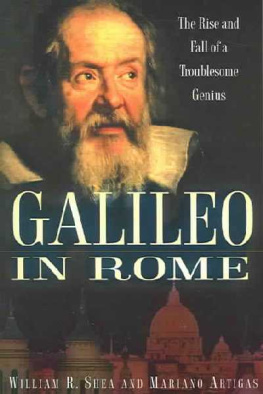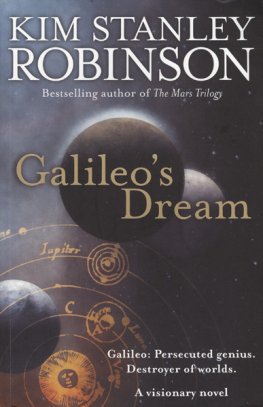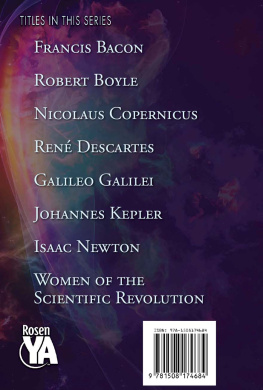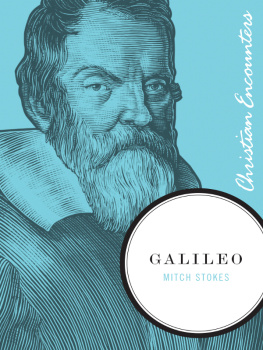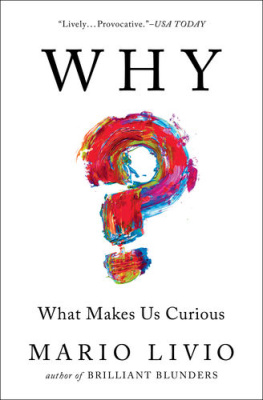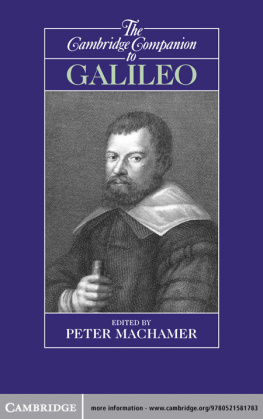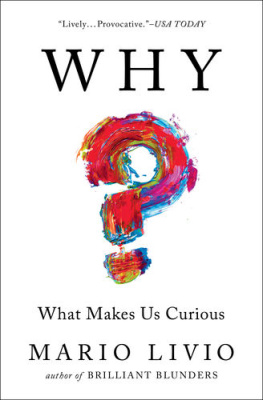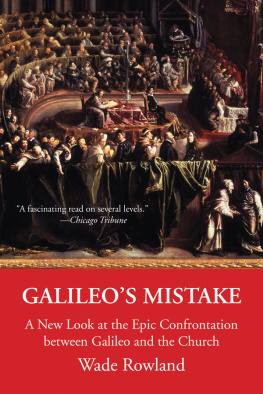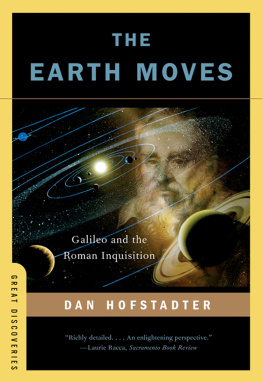Galileo in Rome
The Rise and Fall of a Troublesome Genius
William R. Shea and Mariano Artigas
ACKNOWLEDGEMENTS
We wish to thank most warmly the Templeton Foundation for providing us with a grant to coordinate our work and carry out research in the archives in Rome and Florence. We are also grateful to Paolo Galluzzi and his staff at the Institute and Museum of the History of Science in Florence, to Monsignor Alejandro Cifres, who has made the Archives of the Holy Office in the Vatican a friendly place to work, and to the officials of the Vatican Library, the Biblioteca di Archeologia e Storia dellArte and the Biblioteca Vallinceliana in Rome. We owe special thanks to Lucia Caravale of the Societ Dante Alighieri in Rome for making available documents regarding the Palazzo Firenze, where Galileo spent a great part of his time in Rome, and to several others whom we are pleased to mention here: Corrado Calisi of the Biblioteca della Camera dei Deputati, who introduced us to the Galileo Rooms that were formerly part of the convent of Santa Maria sopra Minerva, where Galileo was tried; Irene Trevor of the American Academy in Rome, who graciously allowed us to visit the Casa Rustica, where Cesis dinner in honour of Galileo took place in 1611; Cosimo di Fazio, who provided information on the Florentine residences of Galileo and enabled us to visit the Convent of San Mateo in Arcetri; Mario Sirignano, of the Accademia dei Lincei who taught us to walk in Galileos footsteps in Rome; the librarians of the Biblioteca Nazionale and of the Archivio di Stato in Florence; Rafael Martinez of the Pontifical University of the Holy Cross in Rome, who undertook a detailed study of a manuscript on Galileo that contains novel and exciting material that one of us (Mariano) came across in the Archives of the Congregation for the Doctrine of the Faith in the Vatican (formerly the Holy Office). Special thanks to Eugenio Calimani, the Dean of the Faculty of Science of the University of Padua, for providing a friendly and stimulating environment in which to complete our book.
INTRODUCTION
Galileo is the father of modern science and a major figure in the history of mankind. He belongs to the small group of thinkers who transformed Western culture, and his clash with ecclesiastical authorities is one of the most dramatic incidents in the long history of the relations between science and religion.
In 1633 the Roman Inquisition condemned Galileo for teaching that the earth moves. The trial was the outcome of a series of events that are described in this book and are usually referred to as the Galileo Affair. It extended over a period of several years, during which different popes, cardinals, and civil personalities entered the scene and made their exit. We can even speak of two Galileo trials, one in 1616 and the other in 1633, although only the second was a trial in the legal sense. The new science, which today pervades our entire life, was just emerging, and very few were able to realize what was happening at the time. Most people were not ready to abandon cherished traditional ideas for daring hypotheses that had yet to be proved.
Galileo made six long visits to Rome, totaling over five hundred days, during which he met the pope, high-ranking members of the Church and the nobility, as well as leading figures of the literary and scientific establishment. His career can be seen in a novel and fascinating way when studied from the vantage point of the city where he was most anxious to be known and approved. This is what our work does for the first time. Each chapter corresponds to one trip, thereby providing a clear framework for the main events of Galileos life and allowing a fresh insight into the nature of the problems that he faced.
Galileo was deeply influenced by his close contacts with members of the ecclesiastical and the scientific community in Rome and, as time went on, he changed his agenda to fit new circumstances. He sometimes met with success, but he ultimately overplayed his hand and the outcome was dramatic. On the short term, his strategy was a failure; on the long term, he clearly emerged the winner.
The six trips occurred over a period of 46 years. The first took place in 1587, when Galileo, then 23 years old, went to Rome to meet scientists who might help him obtain a university appointment. With the assistance of Christopher Clavius, a Roman Jesuit professor, he got his first job at the University of Pisa in 1589 and, in 1592, he moved to the University of Padua, where he spent the next 18 years. After the publication of his astronomical discoveries had transformed him into a celebrity, Galileo returned to Florence, where he became the mathematician and philosopher of the grand duke of Tuscany. The next year, in 1611, he undertook a second and triumphal trip to Rome. He was made welcome by top-level members of the Church and the teaching profession. Unfortunately, his celebrity also gave rise to jealousy and opposition, especially when he began defending in public the Copernican view that the Earth is in motion and revolves around the Sun. This went against the commonsensical view that the Earth (and therefore humanity) is at the center of the universe, a belief that current scientific shared with tradition and Christian doctrine.
The opposition first arose among Aristotelian professors, but they soon managed to involve clerics who did not relish having to reinterpret Scripture in the light of new ideas. Galileo found out that he had been denounced to the Holy Office, and he traveled to Rome for the third time in December 1615 in order defend himself and avoid the condemnation of the heliocentric theory. He was brilliant in discussion, but to no avail. Copernicuss book on the motion of the Earth was banned in 1616, and Galileo was admonished not to teach it. He returned to Florence and was silent on the matter until his friend and admirer Maffeo Barberini was elected pope in 1623, taking the name of Urban VIII. A year later Galileo made his fourth trip to Rome, where he was received six times by the pope. This trip was another triumph, and Galileo felt he could now publish his ideas as long as they were presented as conjectures. This is how his celebrated Dialogue on the Two Chief World Systems came to be written, and in 1630 Galileo made a fifth trip to Rome to request permission to print the book. A number of complications arose, and the work only appeared in Florence in 1632. A loud outcry was raised and Galileo was summoned to Rome, where he was put on trial in 1633. His book was censored, and he was condemned to prison, a sentence that was immediately commuted to house arrest.
The Galileo Affair remains as fascinating as ever, and it has much to teach us that is relevant to our own day. We believe it is the first step in a proper assessment of the relations between science and religion, and we hope that our account will help readers come to grips with the issue and enable them to answer for themselves questions that often arise concerning the affair. We have avoided technicalities, but the book is based on first-hand research and the reader will find the sources of our quotations at the end of the book. We have carefully checked out the slightest details and have been able to correct inaccuracies that are found in the best books on the subject. We have combined our respective knowledge of science and religion (one of us teaches history of science, and the other is a philosopher who is also a physicist and a Roman Catholic priest). The priest often saw Galileos point before the historian; the historian frequently reminded the priest that the Church had sound arguments.
CHAPTER ONE
Job Hunting and the Path to Rome
FIRST TRIP 1587
In the autumn of 1587, a young man of 23 arrived from Florence on his first trip to the Eternal City. His name was Galileo Galilei, and, in accordance with an Italian custom of calling great men by their first name, we shall continue to refer to him as Galileo. In an age when class consciousness was on the rise in Italy, Galileo was proud of the fact that he descended from a noble family. Originally called Bonaiuti, they had exchanged that name for Galilei in the fourteenth century, although they kept their coat of arms unchanged, a red stepladder on a gold shield, forming a pictograph of the word
Next page
